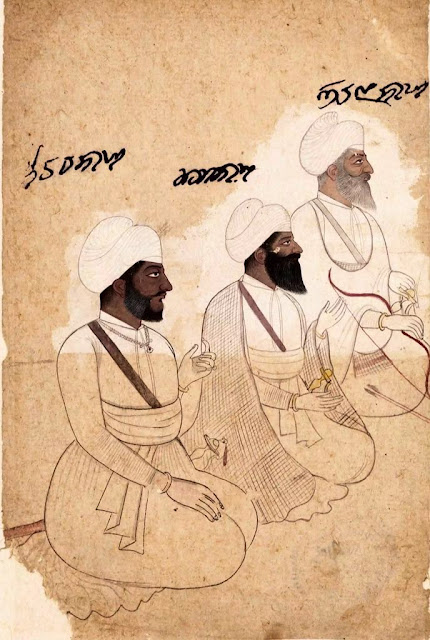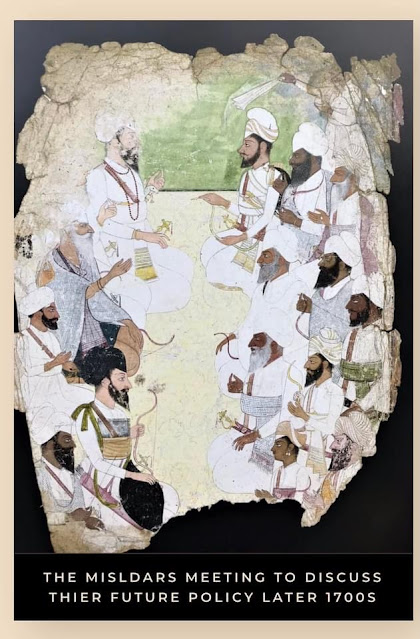Sardar Lehna Singh Kahlon of the Bhangi Misl - my relationship with him.
Welcome to this blog dedicated to the memory of Sardar Lehna Singh Kahlon, the illustrious ruler of Lahore who reigned alongside his nephew, Sardar Gujjar Singh Bhangi, and Sardar Sobha Singh Kanhaiya from 1765 to 1797. Our aim is to pay homage to their legacy and shed light on their contributions to Sikh history.
One of the most significant artifacts that showcases Sardar Lehna Singh Kahlon's grandeur and authority is his portrait, which is housed in the V&A Museum in London. The portrait is widely acknowledged as that of Sardar Lehna Singh Kahlon, as he was the ruler of Lahore who negotiated with Major James Browne of the East India Company in 1783. This fact is corroborated by Dr. Gurinder Singh Mann's book, "The British and the Sikhs," which further attests to the historical significance of the portrait.
We hope that this blog serves as a platform to honor the memory of Sardar Lehna Singh Kahlon, Sardar Gujjar Singh Bhangi, and Sardar Sobha Singh Kanhaiya, who were instrumental in shaping the Sikh history of the region.
Through this blog, we aim to bring their contributions to the forefront and celebrate their lives and In the portrait, Sardar Lehna Singh Kahlon can be seen sitting on the right-hand side. To his left is Sardar Karam Singh, who is related to Baba Deep Singh Shahid, a revered figure in Sikh history. To the left of Sardar Karam Singh is Sardar Nahar Singh Sodhi, who is related to the Sikh Gurus.
This portrait provides a fascinating glimpse into the history of Punjab and the relationships between notable figures of the time. We hope this additional information adds to the reader's understanding of Sardar Lehna Singh Kahlon and his companions in the portrait.
https://collections.vam.ac.uk/item/O153890/painting-unknown/
According to Sir Leppel Griffin's book "The Panjab Chiefs," Sardar Lehna Singh's grandfather hailed from Village Saidowal near Gurdaspur, Punjab. Interestingly, Saidowal is also the Jathera or the original village of people from Kahlwan, which is the author's own village near Kartarpur, Jalandhar.
Sardar Lehna Singh's grandfather migrated to Mustfapur, the author's mother village near Kartarpur, during a famine that hit Punjab in the mid-17th century. The grandfather was adopted by a carpenter in Mustfapur. At present, the Kahlons have four villages in the area, including Mustfapur, Kahlwan, Aima, and Masapur. It is worth noting that when Sardar Lehna Singh's grandfather migrated to Mustfapur, the villages only had Muslim names, as it was still under Mughal rule then.
Sardar Lehna Singh's father, Dargaha, had eight sons, with Lehna being the youngest. At the age of ten, Lehna ran away to be adopted by Sardar Gurbaksh Singh Sandhu of Roranwala in Amritsar, near the Wagah border with Pakistan. While the author is unsure of their direct relationship with Sardar Lehna Singh Kahlon, they do consider themselves a member of his Tubbar, as they say in Punjabi.
In the author's next post, they will delve further into Sardar Lehna Singh Kahlon's fascinating story. For now, we hope that this post sheds some light on their relationship with this notable historical figure and provides some insights into the Kahlon family's history. The author is from Village Kahlwan near Kartarpur, Jalandhar, and currently resides in London, UK.



SSA ji. My dad hailed from Mustfapur. Greetings.
ReplyDeleteUndoubtedly, we are related if you are a Kahlon!
ReplyDeleteI learned of our connection when Buta Singh became Home Minister and my father mentioned that he was our mother village from where we had expanded to Kahlwan, Aima and Musapur (actually, they are all fairly close together - one can walk from Mustfapur to Kahlwan and the others!) - our Jathera is Saidowal near Gurdaspur which is what connects us with Lehna via his grandfather (we should try and find his direct descendants if any at some stage, though due to illness my travelling is limited at the moment - probably recorded somewhere in India such as Hardwar or in Punjab itself).
He had two sons - Chet the elder had a son called Atar Singh, who the British recorded in 1815 had four daughters so they must have married elsewhere. Lehna’s second son was Bhagat who is not heard of further by the British.
You and I are most likely descendants of Lehna’s brothers (he was one of 8 sons of Dargaha, so a large family!), though it would be good if someone in India is able to carry out further research….my great grandfather was Nihal Singh, and that’s as far back as I know of my own history with father and brothers being military men.
Do let me know if any of the relatives in the village have any memories - I also met a Kahlon sister from Village Saidowal who was actually living in Village Kahlwan…who told me our real Jathera is at Village Saidowal…the people who stayed in India know who is who, and have a longer memory than those who migrated abroad like me!